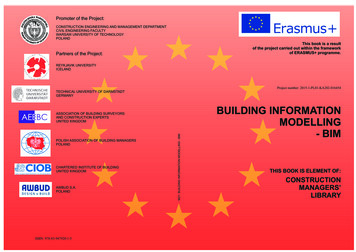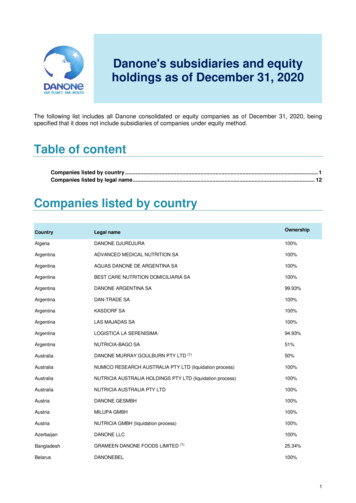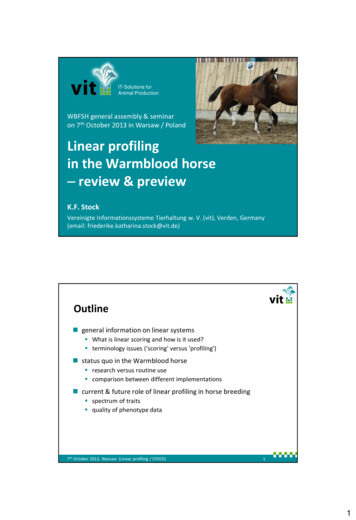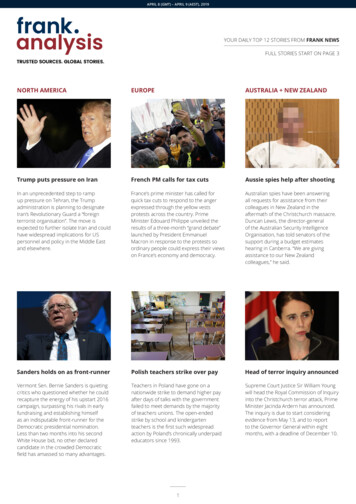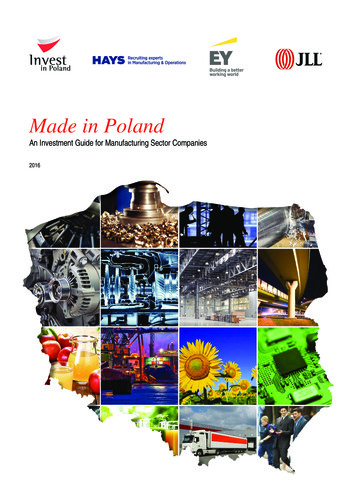
Transcription
Made in PolandAn Investment Guide for Manufacturing Sector Companies2016
2
ContentsForeword.Executive Summary.45Labour Market . . . . . . . . . . . . . . . . . . . . . . . . . . . . . . . . . . . . . . . . . . . . . . . . . . . . . . . . . . . . . . . 8Employment Costs . . . . . . . . . . . . . . . . . . . . . . . . . . . . . . . . . . . . . . . . . . . . . . . . . . . . . . . . . . . 8The Inexperienced Talent Pool . . . . . . . . . . . . . . . . . . . . . . . . . . . . . . . . . . . . . . . . . . . . . 9Experienced Candidates . . . . . . . . . . . . . . . . . . . . . . . . . . . . . . . . . . . . . . . . . . . . . . . . . . . . . 10Unemployment . . . . . . . . . . . . . . . . . . . . . . . . . . . . . . . . . . . . . . . . . . . . . . . . . . . . . . . . . . . . . . 11Grants & Incentives . . . . . . . . . . . . . . . . . . . . . . . . . . . . . . . . . . . . . . . . . . . . . . . . . . . . . . . . . . 14Special Economic Zones . . . . . . . . . . . . . . . . . . . . . . . . . . . . . . . . . . . . . . . . . . . . . . . . . . . . . 14Governmental Cash Grants . . . . . . . . . . . . . . . . . . . . . . . . . . . . . . . . . . . . . . . . . . . . . . . . . . 15Real-Estate Tax - (RETAX) Exemption . . . . . . . . . . . . . . . . . . . . . . . . . . . . . . . . . . . . . . . . 16The Status of an R&D Centre . . . . . . . . . . . . . . . . . . . . . . . . . . . . . . . . . . . . . . . . . . . . . . . . . 16Cash Grants from EU Funds . . . . . . . . . . . . . . . . . . . . . . . . . . . . . . . . . . . . . . . . . . . . . . . . . 16R&D Tax Relief . . . . . . . . . . . . . . . . . . . . . . . . . . . . . . . . . . . . . . . . . . . . . . . . . . . . . . . . . . . . . . 17Key Manufacturing Sectors in Poland . . . . . . . . . . . . . . . . . . . . . . . . . . . . . . . . . . . . . . . . 20Manufacturing Sector is Evolving . . . . . . . . . . . . . . . . . . . . . . . . . . . . . . . . . . . . . . . . . . . . . 20Expanding Sectors in Poland . . . . . . . . . . . . . . . . . . . . . . . . . . . . . . . . . . . . . . . . . . . . . . . . . 20Food Processing . . . . . . . . . . . . . . . . . . . . . . . . . . . . . . . . . . . . . . . . . . . . . . . . . . . . . . . . . . . . 21Domestic Appliances. . . . . . . . . . . . . . . . . . . . . . . . . . . . . . . . . . . . . . . . . . . . . . . . . . . . . . . . . 24Electronics . . . . . . . . . . . . . . . . . . . . . . . . . . . . . . . . . . . . . . . . . . . . . . . . . . . . . . . . . . . . . . . . . 25Automotive Sector . . . . . . . . . . . . . . . . . . . . . . . . . . . . . . . . . . . . . . . . . . . . . . . . . . . . . . . . . . . 26Aviation Sector . . . . . . . . . . . . . . . . . . . . . . . . . . . . . . . . . . . . . . . . . . . . . . . . . . . . . . . . . . . . . . 28Investment Climate in Poland . . . . . . . . . . . . . . . . . . . . . . . . . . . . . . . . . . . . . . . . . . . . . . . 30Investors Are Satisfied with Doing Business in Poland . . . . . . . . . . . . . . . . . . . . . . . . . . 30Poland’s Real Estate Market is at a Maturing Stage.34Rent or Buy? That’s the First Question to Ask! . . . . . . . . . . . . . . . . . . . . . . . . . . . . . . . . 35Buying a Facility? Three Main Options . . . . . . . . . . . . . . . . . . . . . . . . . . . . . . . . . . . . . . . . . 36Market Practice for Leasing or Acquiring Industrial Space . . . . . . . . . . . . . . . . . . . . . 38Real Estate Acquisition . . . . . . . . . . . . . . . . . . . . . . . . . . . . . . . . . . . . . . . . . . . . . . . . . . . . . . 39How to Acquire a Property as a Foreign Company? . . . . . . . . . . . . . . . . . . . . . . . . . . . 39Tax Structures in PolandSetting-up a Business.41.42About Partners . . . . . . . . . . . . . . . . . . . . . . . . . . . . . . . . . . . . . . . . . . . . . . . . . . . . . . . . . . . . . . 43Made in Poland 2016 3
ForewordDuring the last quarter of the century, Poland made thelong journey from being a failing communist state to beinga developed market economy and a significant growth pole inthe European Union. It is today the sixth largest EU state interms of economic output, with growth forecasts for the nextcouple of years being considerably higher than the EU average.Poland’s economic and demographic weight is not to beunderestimated: with its 38 million inhabitants the countryis a large consumer market. Its strategic location in the heartof the continent, where the east-west and north-south routesintersect, makes it a unique and attractive place for industrialinvestments.The country has been improving its competitive edge withlarge investments in infrastructure, which leverage on itsattractiveness stemming from its location in Central Europe.Today, the modern road network provides convenientconnections with most of its neighbours, including Germany.This, coupled with a highly skilled and motivated workforce,and favourably low labour costs, alongside the availability ofinvestment incentives make Poland a very attractive businessfriendly location.The very positive feedback we received to the first edition ofthe “Made in Poland” report, which provided a local insight andguidance into investing in the country, convinced us to onceagain team up with our partners: the Polish Information andForeign Investment Agency (PAIiIZ), EY and Hays Poland. Thisco-operation has allowed us to provide you with the most up-todate report yet. 4 This report aims to offer guidance to international manufacturingsector companies that wish to establish a presence in Polandand gives an inside view of the country’s manufacturinglandscape. It also offers comprehensive expertise on the Polishlabour market with regard to the manufacturing sector andadvice on important legal topics, such as the structure of grantsand incentives, setting-up a business, and tax. Insights on themanufacturing industry also include analysis of sectors. Thecommentary on the real estate market provides a guide to thedifferent acquisition and rental methods, timeframes and marketpractices.We would like to thank all of the partners involved for theirvaluable input in preparing this report. We firmly believe that“Made in Poland” is a useful source of information aboutinvesting in this country.Tomasz OlszewskiHead of Industrial Department CEEJLLSławomir MajmanPresident of the BoardPolish Information and Foreign Investment Agency
Executive SummarySince Poland’s accession to the European Union in 2004, itseconomy has been growing at an average rate of 3.9% perannum. Strong economic fundamentals were evidenced duringthe recent global financial crisis, when Poland’s economy, unlikemany other European countries, did not fall into recession. Infact, Poland is often held up as a role model for economiesundergoing transformation.The country is stably anchored within the European Union andfor the last few years has in fact been one of the EU's maingrowth engines. With its location in the heart of the Europeancontinent and its recently much improved transport links, Polandis today a growing manufacturing hub, attracting companiesfrom numerous production sectors.The characteristics outlined above have led to Poland becomingan established exporter of industrial products, a convenientlocation for production of goods and the gateway to the CEEand the European Union.The Labour MarketPoland offers favourable investment conditions formanufacturers looking to expand in Europe. There are morethan 370,000 entities operating in the manufacturing sectoracross the country, employing more than 2.3 million people.Polish employees are perceived as highly skilled and motivated.However, the costs of labour and social security contributionsare still markedly lower than in the majority of Europeancountries. Poland’s education system is well connected to thelabour market, with increasingly higher numbers of technicaland vocational schools graduates.Attractive Public Aid ProgramsIn addition to the above, manufacturers investing in Poland canchoose from a wide range of opportunities for obtaining financialsupport from both the European Union and domestic sources.Attractive incentives are offered in the form of government cashgrants, tax exemptions in Special Economic Zones (SEZ), realestate tax exemptions (RETAX) and R&D tax relief.The Evolving Manufacturing SectorThanks to its strategic location in the heart of the continent,adjacent to Germany, Poland is an attractive investmentlocation for European manufacturers. The key drivers of FDI aredomestic market growth potential and proximity to Europeanmarkets, closely followed by infrastructure, logistics and theavailability of a skilled labour pool.Poland also attracts manufacturers from overseas markets as itoffers a regional platform to both: the CEE (Central and EasternEurope) region, with some 100 million consumers, and thewider European Union market of 500 million customers.Industrial production in Poland is increasingly more advanced,with growing output from the electronics, automotive andaviation sectors, to mention just a few.A recent study found that investors appreciate Poland as alocation for doing business and the vast majority would investhere again.A Maturing Real Estate SectorThe modern industrial real estate market offers a wide variety ofopportunities for manufacturers . The market is transparent andinvestors can make informed decisions as to whether to own orrent a facility. The permitting process is clear and the amount ofprime industrial land available in Poland is increasing.The market is highly competitive, featuring the presence ofmany large international developers, who offer high qualitymanufacturing and warehouse space. The existing supply is nolonger restricted to the main industrial clusters and developershave land banks allowing for the rapid development of newschemes in a number of prime and secondary locations.There are a number of legal structures that can be used fordoing business in Poland. Most of them are available to Polishand foreign investors based in the EU or EFTA membercountries or countries which have entered into specificinternational agreements with the EU.Made in Poland 2016 5
Its large, talentedand cost-efficientlabour pool is oneof the key locationadvantages of Poland. 6
Labour MarketHuman capital is a key element to consider when undertakingany serious investment, with three main areas to assess: employment costs size of the experienced talent pool size of the inexperienced talent pool (tertiary andsecondary education graduates).While the first two give a snapshot of the current state ofopportunities, the third one is very important for the longerterm. When taking these factors into account and whencomparing to other EU countries, alongside the requirementsof the manufacturing sector, it is apparent that Poland offersfavourable investment conditions.Employment CostsAs graph below shows, Poland offers some of the lowest labourcosts in the EU.Hourly Total Labour Costs in EurosThe two most important components of employer costs aresalaries and social security contributions. The salary ranges forroles typical for manufacturing companies in Poland arepresented below.\Gross Monthly Salary Ranges in PLN forManufacturing RolesMINOPTMAXPlant Manager (up 100 FTEs)13,50017,50022,000Plant Manager (100-500 FTEs)16,50026,00035,000Plant Manager (more than 500 FTEs)30,00035,00040,000Production Manager8,50012,00020,000Shift Leader (Mistrz) (50-100 FTEs)4,5007,0009,000Production Planner (3-5 years of exp.)4,0006,0008,000Quality Manager9,50014,00020,000Quality Process Engineer (3-5 years of 11,50014,50020,0005,0007,50010,000Project Manager8,50013,00020,000Project Engineer (3-5 years of exp.)5,5008,00011,000Lean Manager11,50016,00025,000Black Belt10,00014,00020,0005,5008,00011,000Maintenance Manager7,50012,50018,000Maintenance Engineer (3-5 years of exp.)5,0007,00010,000Tooling Engineer (3-5 years of exp.)7,0009,00012,000Electrician (3-5 years of exp.)4,5006,0007,500Mechanic (3-5 years of exp.)4,5006,0008,000Design Engineer (3-5 years of exp.)5,0007,00010,000EHS Manager8,00011,50018,000EHS Specialist (3-5 years of exp.)5,0007,00010,000Purchasing Manager9,00014,00020,000Purchasing Specialist (3-5 years of exp.)4,5006,5009,000Commodity Buyer7,50010,50015,000Project Buyer7,5009,50012,000Logistics Manager8,50013,50018,000Supplier Quality Assurance Engineer(3-5 years of exp.)Customer Quality Engineer (3-5 years of exp.)Engineering ManagerProduction / Process Engineer (3-5 years of exp.)Lean Manufacturing Engineer (3-5 years of exp.)Source: Hays analysis based on Eurostat, 2014What is even more important, labour costs in Poland aregrowing at a much slower pace than those in Romania andBulgaria. We may assume that, with average growth rates of8.7% and 12.3% respectively, costs in these countries will berising at a very fast pace. The changes that have occurred inthe labour costs over the period of the last 6 years (2008 100)are presented below.Changes in Total Labour Costs Since 2008Logistics Specialist (3-5 years of exp.)4,5006,0009,000Warehouse Manager6,0008,50013,000Transport Manager6,0009,50013,000Source: Hays Poland Salary SurveyIt is worth noting that salary levels can increase when seekingspecialists with niche skills and/or when relocation is required.Source: Hays analysis based on Eurostat, 2014 8 When assessing employment costs, the variations betweenaverage salaries in each Polish region should also beconsidered. Salary levels mostly depend on the developmentof each region, as well as the type of industry situated in that
particular area. This is why the highly industrialised Śląskieand Dolnośląskie regions have average salaries within themanufacturing sector that are up to 20% higher than thepoorer and less developed regions of eastern Poland, such asLubelskie and Podkarpackie (according to data from GUS forQ1 2015).The second element of total labour costs are social securitycontributions. The average level of those in Poland isapproximately 20% of gross annual salary. The final amountdepends on the company’s type of activity (that influences thesize of the contribution to the Injury Fund) and the employee’ssalary (the contributions are significantly lower after crossingthe threshold of PLN 121,650 of annual salary).Employers’ National Insurance ContributionsNationalInsurance oyeeGuaranteed FundHealthTOTALEmployer’s Contributionfor salary up toPLN 121,6509.76%6.50%0.40% - 3.60%2.45%Employer’s ContributionabovePLN 121,6500.4% - 3.60%2.45%0.10%0.10%19.21% - 22.41%*2.95% - 6.15%*Source: Hays own elaboration based on Social Insurance Institution (ZUS), 2016The amounts of the contributions to various Funds is presentedin table above.It is also worth noting that Social Security Contributions aresignificantly lower in Poland that in other CEE countries, suchas Slovakia (35.2 %), the Czech Republic (34%) and Hungary(28.5%).The Inexperienced Talent PoolMany businesses co-operate with universities by offeringtraineeships to both students and graduates. Some companiesdecide to extend this co-operation and become involved in theeducational process by organising courses or sponsoringindustry-related events held at universities. Businesses from themanufacturing sector are happy to employ graduates with noprofessional experience. Possible gaps in skills and knowledgecan be quickly dealt with by additional in-company trainingcourses. Graduates are most often expected to be open to newexperiences, to be ready to learn and be involved.Secondary School GraduatesVocational and secondary technical education was in declinefor a few years following accession to the EU, so in 2012 thegovernment introduced reforms to make them more attractiveto potential students and also to bring the elements of sucheducation closer to the needs of the labour market.One of the highlights of the reforms was the introduction ofqualification frameworks, where qualifications are put togetherto make up the vocation. This made the system more flexibleand enabled schools to create new programs in response tochanges in the labour market. In the school year 2013/2014more than 535,000 young people were studying at technicalsecondary schools and there were more than 185,000students at vocational schools.These schools have variouseducational profiles and the numbers of students for eachof the profiles are presented below. The most relevant fieldsof study for the manufacturing sector are Engineering andManufacturing & Processing, which were chosen by more thanhalf of vocational school students and more than a quarter ofsecondary technical school students.Students in Vocational and Technical Secondary Schools by Field of Education39.5%25.1%Vocational ng& Processing13.1%Architecture& Construction7.5%IT alSciences11.0%9.0%Secondary Technical SchoolsSource: Hays analysis based on Central Statistical OfficeMade in Poland 2016 9
Tertiary School GraduatesTechnical studies are also becoming increasingly popular inPoland, thanks mainly to growing awareness among futurestudents and some government programs. In 2014, the fourmost popular higher education institutions (in terms of thenumber of applications) were technical universities. WarsawUniversity of Technology was the most popular one, with 7.9applicants for every place. The number of graduates has alsobeen growing, as shown in graph below.What is worth noting is that the total number of graduates inPoland is declining and thus the share of engineering graduatesin the total number of graduates is growing. In 2014 it was7.0%, up by 0.6 percentage points compared to 2013.Knowledge of Foreign Languages Among EngineeringStudents and Pupils at Secondary Technical : Hays analysis based on BKL Survey, sample 6,000 students; 16,000 pupilsTechnical University Graduates in PolandExperienced CandidatesIn 2014 there were over 370,000 organisations operating inthe manufacturing sector in Poland, employing more than2.3 million people, in excess of a quarter of whom were workingin the Mazowieckie and Ślaskie regions alone. Other importantmanufacturing regions in Poland are Wielkopolskie andDolnośląskie, as shown on the map below.The Share of Individual Regions in the Employment in theManufacturing Sector in 2014Source: Hays analysis based on Central Statistical Office5.8%ZachodnioPomorskieKnowledge of Foreign LanguagesCandidates for engineering positions are almost alwaysrequired to speak at least one foreign language, usuallyEnglish. However, increasingly often technicians are alsorequired to be able to read and write in English as more andmore often technical documentation is only available in thatlanguage. In recent years, Hays Poland specialists have alsoobserved a growing demand for German speakers, especiallyin the western Polish regions such as Dolnośląskie andWielkopolskie.The graph below shows the self-declared levels of languageproficiency for engineering students and pupils at secondarytechnical and vocational schools in Poland.It is worth noting that the level of German is higher amongpupils than among students. One possible explanation is thegrowing awareness among pupils of the importance of foreignlanguages – German as a language of choice reflects thestrong ties of Polish industry to that of our western neighbour. 10 % 14.1%OpolskieŚląskie karpackieMałopolskie2%Source: Hays analysis based on Central Statistical OfficeThe largest manufacturing sector in Poland in terms ofemployment is the food & beverages industry, which in 2014employed almost 440,000 people. The second largest is themetal industry (including arms industry) and the third is theautomotive sector, which also has the largest average numberof employees per company – 34 in one entity.
Employment in the Manufacturing Sector by Industry in 201312%Foodand beverages18%Rubberand plastic products7%Furnitureand wood products6%Electronicsand electrical equipment6%Textiles6%Other non-metallicproducts5%Machinery5%Wood products5%Repairand maintenance5%Chemicals3%3%Paperand paper products2%Printing and reproductionof recorded media2%Basic metalsMetal productsOther manufacturing9%Automotive5%Source: Hays analysis based on Central Statistical OfficeUnemploymentAt the end of October 2015 Poland’s unemployment rate was9.6%: 0.1 percentage points lower than in September 2015and 1.7 percentage points lower than the same month in 2014.Average Unemployment Rate in Polandin Q1-Q3 2015 by 9%OpolskieAs mentioned previously, the unemployment map can showthe parts of the country where there is an accessible labourforce, although it is worth considering that there are certainsub-regions in some of the most developed regions that alsohave high unemployment rates (such as Radomski, nearWarsaw, and Bytomski in Śląskie). These regions can enablean investment to be made near a major hub, such as Warsaw,whilst also providing easy access and cheaper costs of thelabour force, particularly when hiring blue-collar 7%KujawskoPomorskie12.8%Lubuskie18.9%PomorskieWhen analysing the Polish unemployment map, the differencesbetween regions are significant. The more developedregions, such as Wielkopolskie, Mazowieckie and Śląskie,have an unemployment rate of below 10%, while in someless developed regions, such as Warmińsko-Mazurskie andKujawsko-Pomorskie, this rate is often above 15%.9.9%Małopolskie14.8%Andrzej DąbrowskiOperations Managerat SGX Europe Sp. z o.o.Podkarpackie10%5%Source: Hays analysis based on Central Statistical OfficeThe total number of registered unemployed persons in Polandat the end of Q4 2015 was over 1.55 million. This representsa significant readily-available talent pool. Polish employersare also able to obtain partlial refunds for the costs of trainingfor newly-hired staff previously registered as unemployed (themaximum amount is 50% of the total training cost but no morethan the national average wage; for individuals aged 45 andabove, it is up to 80% but no more than 300% of the nationalaverage wage).„SGX Europe is a part of SGX Sensortech global high technologycompany. The business entity was set up in Katowice in August 2015. Ourmain focus was to build a team, which will serve as a key point for ourdevelopment.In Poland, our employees are motivated, well-educated and open to newchallenges. High technology solutions delivered by SGX Sensortech aswell as the engagement and creativity of Polish employees ensure thesuccess of our business.The aspects that make Poland an attractive localisation for investmentsare the considerable size of dynamically growing market, complexinvestment portfolio, the availability of potential suppliers and the supportof local authorities.”Made in Poland 2016 11
Investors can choosefrom a wide spectrumof public aid programs,particularly developedto supportthe manufacturing sector. 12
Grants & IncentivesIntroductionChoosing the appropriate location for an investment requiresa thorough analysis of the potential costs and benefits of thesites. One of the key factors influencing decisions on location isoften the availability of state aid.There are many opportunities for companies to obtain financialsupport for projects in Poland from both European Unionfunds and domestic sources. In this publication we focus onthe most popular of the aid schemes available for investorsfrom the manufacturing sector. But one should note that whenconsidering a new investment in Poland, it is important for eachcase to be analysed individually – various sources and types ofsupport may be available, depending on the scope of a givenproject, size of enterprise and timing of calls for application.Investors from the manufacturing sector take the above intoconsideration as they can benefit from different types of stateaid in Poland, including, among other incentives, corporateincome tax exemption in Special Economic Zones (‘SEZ’),governmental cash grants (formerly the Multi-Annual SupportProgramme – MASP) and real estate tax exemption (RETAX).However, it is worth to notice, that governmental cash grantprogramme is at present subject to review and update.The permitted maximum amount of regional aid for a chosenlocation is expressed as a percentage of the higher of: eligible investment costs; and two year employment costs of the newly created jobs.Special Economic ZonesSpecial Economic Zones are parts of Poland set up for aspecific period of time (until 31 December 2026) wherecompanies’ operations are governed by specific rules. Atpresent, there are 14 SEZs in Poland (as indicated on the mapon the left below). Each SEZ consists of several sub-zoneswhich are located in different places, not necessarily next toeach other.The CIT exemption in SEZs is granted under Polish law forcompanies which have obtained a SEZ permit. That permitspecifies the following conditions which the investor must meet: value of the planned investment;intended level of employment;date of commencing the business activity; anddeadlines for fulfilling all of the obligations mentioned in thepermit.The decision regarding location may be determined not onlyby the forms of state aid available to the investor, but also bythe complexity of the procedures regulating the application forSEZ permit also specifies (by reference to Polish statisticala particular form of support in different regions of Poland. Theclassifications) the activities to be performed in the SEZselected location of an investment is conditioned by the amountwhich qualify for tax exempt income (revenues from activitiesof support available. Also, the maximum level of state aid isnot explicitly mentioned in the SEZ permit are taxable underconnected with the location of the investment and the size ofstandard rules, i.e. CIT – at a 19% rate). There is a list ofthe investor (small / medium-sized / large company). For theactivities which cannot be covered by a SEZ permit.percentages of “maximum aid intensity” applicable in a givenEach permit is valid until the end of the SEZ's existence in 2026region where a project is to be located – please see on the map(according to currently effective law).below.Map of Regional Aid Intensities in Poland, 2014-2020Source: Council of Ministers' Regulation dated 30 June 2014 setting out the regional aid map for years 2014-2020 (Dz.U.2014.878) 14
Income generated from business activities carried out by aninvestor in a SEZ is CIT-exempt up to the level in accordancewith the below formulas: (maximum aid intensity) x eligible investment costs; and (maximum aid intensity) x two year employment costs ofthe newly-created jobs.It is important to note that, in principle, investment activities maystart only after a SEZ permit has been issued.In order to receive a SEZ permit an investor may either: set up in an existing SEZ (i.e. plan an investment on landalready covered by SEZ status); or apply for a SEZ extension (i.e. request that a SEZ status isgranted to new land and then apply for an SEZ permit.This decision is crucial, as it may affect the projectimplementation schedule. One should keep in mind that whileentering the existing SEZ can be completed within six to eightweeks, SEZ extension can take from six months to a year. Asthere is not always a suitable location with SEZ status, SEZextension is sometimes worth considering.Governmental Cash GrantsPolish government grants (formerly the Multi-Annual SupportProgramme – MASP) come from a regional aid schemefinanced from the State budget and dedicated to supportinglarge investments considered vital to the Polish economy.Support from the MASP may be granted to: investments in the “priority sectors”; i.e. the automotive,electronics, aviation, biotechnology, modern services(particularly IT centres, BPOs and telecommunications)and R&D sectors; and “significant” investments in other sectors.As a rule, support cannot be granted if the local unemploymentrate is lower than 75% of the national average, unless: the investment is conducted in the modern services or R&Dsector; or the investment is located in the Warminsko-Mazurskie,Podlaskie, Lubelskie, Świętokrzyskie or Podkarpackievoivodships or the levels of eligible costs and new jobs meet thethresholds for “significant” investments.Support may be based on the two-year employment costsof new staff hired or eligible investment costs. Depending onthe type of eligible costs, there are different entry criteria forprojects.There are no calls for proposals. Companies can submitapplications at any time during the year.Entry Criteria for Support Based on EligibleInvestment CostsNumberof new jobsEligibleinvestment cost(PLN million)priority sectors, i.e.automotive, electronicsand householdappliances, aviation,biotechnology, foodprocessing andagriculture50160R&D35*10significant productioninvestment in othersectors200500750500SectorLevel ofsupport1.5%-7.5% ofinvestment value (dependingon location)**6%-10% ofR&D investment(depending onlocation)Source: EY own elaboration, * People with university degree** In the case of Eastern Poland the level of supp
Source: Hays Poland Salary Survey: Made in Poland 2016 9 particular area. This is why the highly industrialised Śląskie . and Dolnośląskie regions have average salaries within the manufacturing sector that are up to 20% higher than the poorer and less developed regions of eastern Poland, such as
